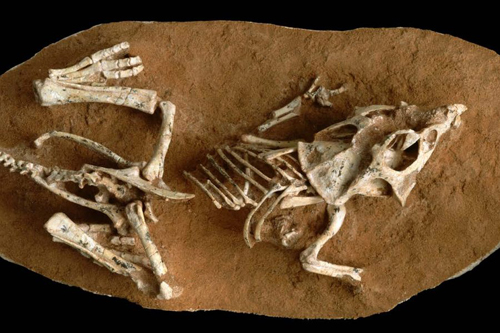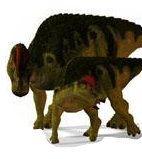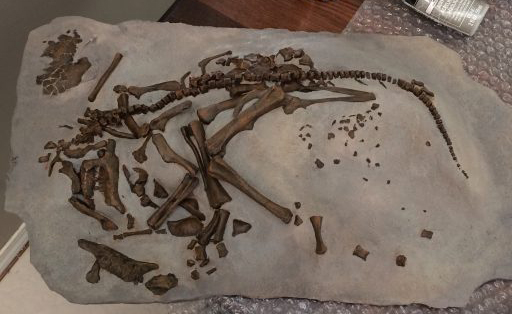How Long Did Dinosaur Eggs Take to Hatch?
Dinosaurs laid eggs, that’s the consensus view in palaeontology, no evidence has been found to date of viviparity for example, but how long did it take for a dinosaur egg to hatch? That question has been answered to some extent thanks to some fascinating research conducted by scientists at Florida State University working in collaboration with colleagues at Calgary University (Alberta, Canada) and the American Museum of Natural History (New York).
Studying a Dinosaur Egg
This study might shed light on why the Dinosauria were unable to recover from the climate catastrophe that marked the Cretaceous/Palaeogene (K-Pg) extinction event.
The Teeth of Protoceratops Embryos were Included in the Study
Picture credit: Gregory Erickson (Florida State University)
The researchers examined the embryonic teeth of dinosaurs, preserved entombed in fossilised eggs. In some extant animals, as the embryo grows, so the teeth record daily growth rates. Lines observed on an embryonic tooth can be used to determine how quickly the embryo was growing and therefore, by implication, how long it took the dinosaur to hatch.
For dinosaur models and figures: Dinosaur and Prehistoric Animal Models.
Two Different Dinosaurs Studied
Writing in the Proceedings of the National Academy of Science, the researchers calculate that in the two types of dinosaur they studied (Protoceratops and the hadrosaurid Hypacrosaurus), eggs took between three and six months to hatch.
Commenting on the study, lead author Professor Gregory Erickson (Florida State University) stated:
“Some of the greatest riddles about dinosaurs pertain to their embryology, virtually nothing is known. Did their eggs incubate slowly like their reptilian cousins, crocodilians and lizards? Or rapidly like living dinosaurs, the birds?”
The Enormous Late Cretaceous Hadrosaur Hypacrosaurus was Included in the Study
Picture credit: Ohio State University
Embryonic Dinosaurs
Fossils of embryonic dinosaurs are extremely rare. Few specimens have been found, however, there are exceptions. For example, a number of Protoceratops nests have been excavated from Upper Cretaceous deposits in Mongolia, whilst extensive bone beds of Hypacrosaurus have been discovered, including several nesting sites in Alberta and northern Montana (United States). Hypacrosaurus specimens represent a range of ages, from embryos through to fully mature individuals. As a result, this genus has been extensively studied in a bid to discover the growth rates of dinosaurs. It has been discovered that these duck-billed dinosaurs grew very rapidly once hatched, reaching maturity after about two to three years. Hypacrosaurus grew much faster than the predatory tyrannosaurids, with which it co-existed.
To read more about the study of Hypacrosaurus growth rates: Duck-billed Dinosaurs Grew Up Fast to Avoid Getting Eaten.
Studying Dinosaur Embyros
Palaeontologists have postulated that dinosaur egg incubation was similar to that of modern birds. Birds eggs hatch in time intervals ranging from eleven to eighty-five days. Comparable-sized reptilian eggs such as crocodiles, caiman and lizards typically take twice as long to hatch. The American Alligator (Alligator mississippiensis), North America’s largest living reptile, lays an egg around nine centimetres in length that takes between 62 to 68 days to hatch. Komodo Dragon (Varanus komodoensis) eggs, can take much longer, between seven to eight months to incubate.
As some dinosaur eggs can be very large, the eggs of Hypacrosaurus are estimated to have weighed around four kilogrammes and were about the size of a volleyball, scientists believed that the embryonic dinosaurs would have incubated rapidly, a characteristic inherited by the dinosaur’s near relatives, the birds.
Professor Erickson with Florida State University graduate David Kay and collaborators from the American Museum of Natural History and the University of Calgary, decided to test this hypothesis.
Co-author of the paper, Darla Zelenitsky (Assistant Professor of Geoscience at the University of Calgary) explained:
“Time within the egg is a crucial part of development, but this earliest growth stage is poorly known because dinosaur embryos are rare. Embryos can potentially tell us how dinosaurs developed and grew very early on in life and if they are more similar to birds or reptiles in these respects.”
Using a CT Scanner
Professor Erickson and his team ran the embryonic jaws through a CT scanner to visualise the forming dentitions (teeth). Then, they extracted several of the teeth to further examine them under sophisticated microscopes.
Researchers found what they were looking for on those microscope slides. Growth lines on the teeth showed researchers precisely how long the dinosaurs had been growing in the eggs.
Embryonic Remains of a Hypacrosaurus
Picture credit: Darla Zelenitsky (University of Calgary)
Professor Erickson added:
“These are the lines that are laid down when any animal‘s teeth develops. They’re kind of like tree rings, but they’re put down daily. We could literally count them to see how long each dinosaur had been developing.”
Studying Protoceratops and Hypacrosaurus
The team’s research indicates that the sheep-sized Protoceratops took three months to hatch, whilst the much larger Hypacrosaurus took six months to incubate.
Fellow author of the study, palaeontologists Mark Norell (American Museum of Natural History), said:
“Dinosaur embryos are some of the best fossils in the world. Here, we used spectacular fossil specimens collected by American Museum expeditions to the Gobi Desert, coupled them with new technology and new ideas, leading us to discover something truly novel about dinosaurs.”
The Implications for a Species with a Relatively Long Incubation Period
This study suggests that, in the two species examined, the incubation period of the dinosaurs has more in common with primitive reptiles than with their close relatives the birds.
Dinosaur eggs would have been vulnerable to attack from predators, or at risk from flooding, trampling and other dangers for far longer than previously thought. The long incubation period could have contributed to the extinction of the Dinosauria at the end of the Cretaceous. Most palaeontologists now believe that the majority of the Dinosauria were endothermic (warm-blooded). If this is the case, then they would have required considerable resources to grow quickly once hatched to reach breeding age.
Using this data, it can be postulated that decimated populations after a global catastrophe such as an extra-terrestrial impact event or excessive volcanic activity may not have been able to recover. Essentially, the dinosaurs may have been out-competed to some extent by the rapidly breeding small mammals or the birds with their speedier egg incubation rates.
Professor Erickson concluded:
“We suspect our findings have implications for understanding why dinosaurs went extinct at the end of the Cretaceous period, whereas amphibians, birds, mammals and other reptiles made it through and prospered.”
To read an article that suggests a seed-eating habit helped the birds survive the K-Pg extinction event: Seed-eating May Have Helped the Aves Survive the End-Cretaceous Extinction Event.
The Effect on Dinosaur Migration Theories
If dinosaur eggs took a long time to hatch, then the idea of dinosaurs undertaking extensive migrations in order to reach seasonal breeding grounds can be doubted. Many scientists believe that North American dinosaurs migrated northwards to the Arctic circle during the summer having nested in the more temperate lower latitudes. Longer incubation periods make these sorts of long migrations more unlikely.
This research was supported by the National Science Foundation and Everything Dinosaur acknowledges the assistance of Florida State University in the compilation of this article.
Visit Everything Dinosaur’s website: Everything Dinosaur.









It’s not much of an extinction theory based on two species. For a lot of dinosaurs there are no young or eggs to study. There are problems telling male from female.
It appears that all that matters is an eyecatching story.